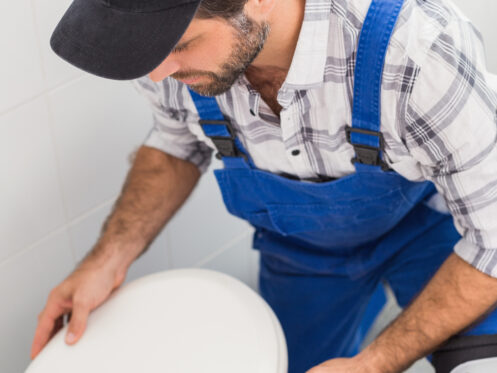Every plumbing fixture has a limited lifespan and will eventually need to be replaced. Knowing when it’s time to replace a toilet in your home is important because it can help prevent issues with high water bills, leaks, and water damage. Here’s everything you need to know about how long toilets usually last and the signs to look for that can help you know when you should have your toilet replaced.
Average Lifespan of a Toilet
Most homeowners end up replacing their toilets around every 10 to 15 years, and this usually happens when they decide to renovate or update their bathrooms. If a toilet doesn’t get tons of use and is taken care of properly, it could potentially last for upwards of 50 years. The problem is that toilets can be prone to staining from rust, mineral deposits, and urine, and this staining is one of the more common reasons why people decide to replace their toilets.
Staining most often happens underneath and around the edge of the rim. The back of the bowl near where it connects to the tank or the very bottom of the bowl where the water flushes out can also get stained over time. If you have a toilet in your home that seldom gets used, it will also often develop a pink ring of mineral deposits in the bowl that results from the water slowly evaporating. As the chain and other metal parts in the tank age, they can also start to rust and lead to red, brown, or orange rust stains developing in the bowl.
If you don’t keep up with cleaning your toilet regularly and scrubbing away the stains, they can eventually be almost impossible to get rid of. Staining will make your toilet look unsightly and unsanitary, which can obviously be embarrassing when you have guests over who need to use the restroom.
Signs That You Should Replace or Upgrade Your Toilet
Knowing when your toilet has reached the end of its life can sometimes be tricky. In addition to staining and discoloration, here are some other things that can indicate it’s time to have your toilet replaced.
Toilet Was Installed Before 1992
If you have any toilets in your home that are more than 30 years old, we’d definitely recommend upgrading them as soon as possible. The reason is that those old toilets are likely wasting lots of water and leading to your monthly water bills being higher than they need to be. As part of the Energy Policy Act of 1992, the U.S. federal government mandated that all new toilets sold in this country must be low-flush models. Also known as ultra-low-flow toilets, these models are required to use no more than 1.6 gallons of water per flush.
If you have a toilet that was installed before the new law went into effect, it could potentially use up to 7 gallons per flush. That means just flushing one toilet three times would use around the same amount of water as taking one shower. To put it another way, 7 gallons is also about the same amount of water that a high-efficiency front-load washing machine uses per load or cycle.
According to the EPA, upgrading all of the old toilets in a home to low-flow models would reduce the typical family’s water usage by around 13,000 gallons per year on average. That’s around the equivalent of taking 650 showers in a year or doing more than 1,800 loads of laundry, which shows you just how much water old, inefficient toilets waste.
Some people are hesitant to switch out their old toilets for low-flow models. There is a common misconception that low-flow toilets don’t work well and that you need to flush them several times for everything to go down. This was a somewhat common issue when low-flow toilets were first introduced, but more recent models are much more efficient and will almost always flush everything in one go. There are also many dual-flush models available that work even better and use even less water. This type of toilet has one less powerful flush for liquid waste and a more powerful flush that will easily handle all of the solid waste and toilet paper.
Toilet Frequently Clogs and Overflows or Constantly Runs
If you have a toilet that frequently clogs and starts overflowing, it indicates that there is a partial blockage in the toilet trap. All toilets have either a P-trap or an S-trap that holds water to prevent sewer gases from being able to flow up out of the pipe. Most blockages can easily be fixed by plunging a toilet, but a total blockage may require having a plumber clean the trap with a pipe snake. However, there are occasionally situations where a plumber can’t remove the obstruction, in which case the only option will be to replace the toilet.
If your toilet constantly runs, you will hear it refilling frequently so that it maintains the correct level of water in the tank. A running toilet typically indicates that one of the components in the tank like the flapper or fill valve has worn out and needs to be replaced. However, it can also happen because the toilet is cracked or the wax ring or toilet flange in the floor underneath the bowl is broken.
Replacing the wax ring or flange requires completely removing the toilet. If your toilet is fairly old, is stained, or has frequent issues, you’re often better off to have it replaced at the same time as the plumber replaces the wax ring or flange. In this situation, the labor costs will be about the same whether you just have the issue repaired or have a new toilet installed. As such, the only extra you’ll have to pay is to purchase the new toilet itself.
Toilet Is Cracked or Leaking
A cracked or leaking toilet can cause extensive water damage and also lead to issues with mold growth. Any time you notice water around the base of the toilet or see any signs of water damage, you should immediately close the valve on the water line next to the toilet. You’ll then want to flush as much water out of the toilet as you can and then use towels or a wet/dry shop vacuum to remove the remaining water.
Once you’ve gotten rid of all of the water, you’ll then need to have a plumber inspect the toilet to determine why it’s leaking. The plumber will also make sure that the rubber gaskets on the bolts that seal the tank to the bowl aren’t worn out since this will lead to water leaking out of the tank onto the floor. If water is leaking around the base of the bowl, it indicates that the wax ring or flange needs to be replaced. These issues can all easily be repaired as long as your toilet is still in good condition. However, if the gasket between the bowl and tank is worn out and leaking, you’re almost always best to replace the toilet. Similarly, if the tank or bowl is cracked, you’ll need to replace the toilet because cracks cannot be repaired.
If you have issues with a toilet that leaks, constantly runs, or simply want to upgrade your toilet, you can trust the experts at Plumbtree Plumbing & Rooter for help. We specialize in all plumbing installation and repair services as well as all drain and sewer services, and we’re available 24/7 to handle any plumbing emergencies. Contact us today for more information or to schedule a service call in San Jose or the Silicon Valley area.

